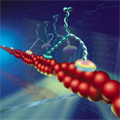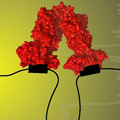For the last dozen years, optical spectroscopy has developed into a powerful set of techniques for exploring the individual behavior of molecules in complex local environments. Observing a single molecule removes the errors that result from averaging across a population of molecules, allows for the exploration of hidden heterogeneity in complex molecular mixtures and provides direct observation of the dynamics and movements of individual molecules. A variety of techniques have been used to study single molecules in biology, including the manipulation of single molecules with optical tweezers, detection using single-molecule fluorescence spectroscopy, and microscopy and scanning methods to study surface topology. Applications of these techniques to questions in biology cover a wide range of topics, as outlined by the examples below.
Myosin V Walks Hand Over Hand
 Myosin V, a dimeric molecular motor protein, moves processively on actin, with the center of mass moving about 37 nanometers for each step. Classic single molecule measurements using nanometer resolution imaging methods generated precise measurements that allowed researchers to distinguish between two longstanding models for myosin movement: the “hand-over-hand” model versus the “inchworm” model. The technique, coined FIONA (Fluorescence Imaging with One Nanometer Accuracy), determined the location of the myosin molecule with nanometer-level resolution and showed that myosin V walks using the hand-over-hand model. Credit: Paul Selvin, University of Illinois; image by Precision Graphics.
Myosin V, a dimeric molecular motor protein, moves processively on actin, with the center of mass moving about 37 nanometers for each step. Classic single molecule measurements using nanometer resolution imaging methods generated precise measurements that allowed researchers to distinguish between two longstanding models for myosin movement: the “hand-over-hand” model versus the “inchworm” model. The technique, coined FIONA (Fluorescence Imaging with One Nanometer Accuracy), determined the location of the myosin molecule with nanometer-level resolution and showed that myosin V walks using the hand-over-hand model. Credit: Paul Selvin, University of Illinois; image by Precision Graphics.
Tethered Protein Provides Answers
 Segments of lactose repressor protein were tethered to DNA to gauge the importance of protein flexibility in forming DNA loops. The V-shaped lactose repressor has two arms connected by a central hinge. When each arm binds to a different site within a single DNA molecule, a loop forms, creating a “pinched-off” section of DNA that is unavailable to DNA polymerase and therefore “repressed.” By varying the length of the tethers, the investigators found that the lactose repressor could no longer form the loops required to repress DNA when it became too short because the flexibility of the protein was too restricted. Credit: Danielis Rutkauskas and Francesco Vanzi, University of Florence, in collaboration with Kathleen Matthews, Rice University. Article abstract
Segments of lactose repressor protein were tethered to DNA to gauge the importance of protein flexibility in forming DNA loops. The V-shaped lactose repressor has two arms connected by a central hinge. When each arm binds to a different site within a single DNA molecule, a loop forms, creating a “pinched-off” section of DNA that is unavailable to DNA polymerase and therefore “repressed.” By varying the length of the tethers, the investigators found that the lactose repressor could no longer form the loops required to repress DNA when it became too short because the flexibility of the protein was too restricted. Credit: Danielis Rutkauskas and Francesco Vanzi, University of Florence, in collaboration with Kathleen Matthews, Rice University. Article abstract